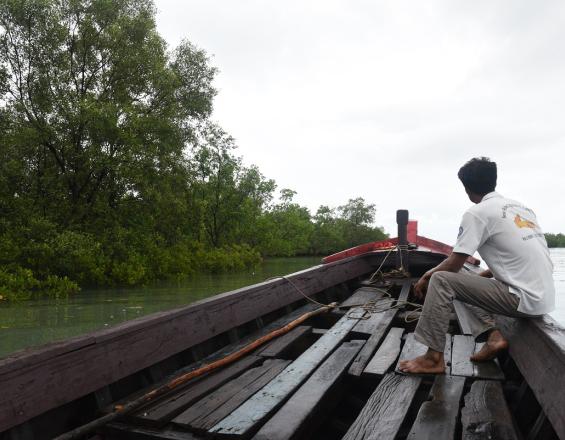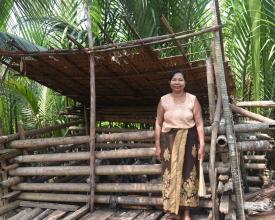
Renforcer les capacités des ONG en matière de conservation et de développement communautaires au Myanmar

L'accord de concession de conservation communautaire (CCCA) est une approche innovante de la conservation qui confère à différentes parties prenantes des droits de protection de l'environnement et des droits de développement limités dans les zones protégées. Il implique les communautés dans les efforts de conservation tout en soutenant leurs moyens de subsistance. En 2016, le modèle CCCA a été introduit au Myanmar par le Global Environmental Institute par l'intermédiaire de quatre ONG locales. Seize projets ont été menés et plus de 4 000 hectares de terres ont été conservés.
En 2017, un projet a été mis en œuvre pour renforcer les capacités des groupes et des organisations du Myanmar en matière de CCCA et de conservation et de développement à base communautaire, dans le cadre d'une stratégie clé visant à maintenir les acquis et à accroître l'impact du modèle CCCA. Avec le soutien du CEPF, GEI a mené une série de formations sur la mise en œuvre des CCCA. Il a construit une plateforme permettant aux ONG locales de collaborer avec les agences gouvernementales, de travailler en réseau avec les donateurs internationaux, et a organisé une série de formations sur la mise en œuvre de la CCCA.
Contexte
Défis à relever
Contrairement à la richesse biologique du pays, au moins un tiers de la population locale vit actuellement sous le seuil de pauvreté et dépend des ressources naturelles pour sa subsistance. Depuis 2010, le Myanmar a perdu environ 546 000 hectares de forêt par an, ce qui signifie que près de 2 % de la couverture forestière du pays disparaît chaque année.
Si le commerce du bois et la remise en état des terres agricoles contribuent à la déforestation au Myanmar, l'abattage illégal de bois de chauffage par les villageois se produit également à un rythme effréné. Les villages ruraux, qui représentent la majorité de la population, consomment environ 1,8 million de tonnes cubes de bois de chauffage chaque année.
Le problème dépasse les capacités des ONG locales. Les ONG du Myanmar n'étaient pas entièrement équipées pour gérer les stratégies de conservation, s'engager avec les parties internationales, ainsi que pour apprendre, partager et mettre en œuvre des pratiques de protection innovantes telles que le modèle CCCA.
Emplacement
Traiter
Résumé du processus
Le premier bloc de construction vise à relever le défi de la capacité relativement faible des ONG locales à gérer les stratégies de conservation, à s'engager avec les parties internationales, ainsi qu'à apprendre, partager et mettre en œuvre des pratiques de conservation innovantes telles que le modèle CCCA. Une fois les capacités renforcées, le deuxième bloc de construction peut répondre efficacement au défi dans lequel les communautés locales sont dépendantes des ressources naturelles, et au besoin de modèles de conservation innovants.
Blocs de construction
Renforcer la capacité des ONG locales à mettre en œuvre un modèle de conservation innovant
Le modèle CCCA est encore nouveau au Myanmar et il est important d'aider les ONG locales à comprendre et à accepter que la conservation nécessite la participation des communautés locales et qu'elles doivent bénéficier des actions de conservation. GEI a organisé deux formations axées sur le modèle CCCA et sa mise en œuvre et a invité des experts internationaux ayant une grande expérience de la conservation communautaire à partager leurs connaissances et leur expérience. GEI a également soutenu une ONG locale pour la mise en œuvre sur le terrain, en fournissant des conseils et en assurant la liaison avec les différents donateurs.
Facteurs favorables
La confiance et le soutien des ONG locales et leur volonté d'accepter le modèle CCCA sont des facteurs clés de succès.
Leçon apprise
L'efficacité des formations et la mise en place de mécanismes de retour d'information et de communication sont essentielles. Même si les ONG partenaires locales ont déjà fait un très bon travail dans la mise en œuvre des projets \ et la création de résultats positifs, certains facteurs clés du modèle CCCA, tels que les sanctions et la collecte de données, manquaient encore dans les projets. Des sessions de formation plus efficaces et des mécanismes de communication plus complets entre l'IEG et les ONG locales pourraient contribuer à les améliorer.
Promouvoir le modèle CCCA afin d'impliquer les communautés dans la conservation et de développer des moyens de subsistance durables.
La démonstration du modèle CCCA dans les communautés pilotes pourrait montrer au gouvernement du Myanmar l'impact que peut avoir l'implication des communautés dans les actions de conservation et l'apport de bénéfices pour ces actions. Avec le soutien du CEPF, GEI et quatre ONG locales partenaires ont étendu le projet à 27 communautés, conservant ainsi deux autres écosystèmes critiques : Le lac Inle et les zones humides de Moeyingyi. La superficie totale conservée par les communautés est passée à près de 17 000 hectares. Le nombre de ménages participants a également augmenté, passant de 4 565 à 21 615 personnes.
Facteurs favorables
De bonnes relations avec diverses parties prenantes, telles que les gouvernements central et locaux, les communautés locales et les ONG locales, ont permis la réussite de ce volet.
Leçon apprise
Les projets ont fait preuve d'un engagement positif auprès des communautés. Même si certaines communautés manquaient de motivation et qu'il était difficile de communiquer avec elles, les ONG chargées de la mise en œuvre ont déployé beaucoup d'efforts pour discuter des projets avec les populations locales et pour montrer qu'elles respectaient les besoins et la volonté des communautés. En revanche, les projets ont moins bien réussi à impliquer les agences gouvernementales et les entreprises. En tant que parties prenantes importantes, elles n'ont pas été identifiées lors du processus initial d'analyse des parties prenantes et n'ont pas eu le même niveau de compréhension des projets CCCA que les ONG et les communautés. Leur engagement et leur participation doivent être pris en compte dans les projets futurs.
Impacts
Grâce au renforcement des capacités, la collaboration entre GEI et les ONG locales a eu un impact positif sur les communautés du Myanmar. Le projet :
- a contribué à la conservation d'un plus grand nombre de terres et d'écosystèmes par les communautés. La zone de conservation protégée par les communautés dans le cadre de ces projets s'est étendue à 16,5 hectares ;
- a montré que la plupart des menaces qui pèsent sur les parcs nationaux peuvent être écartées par des mesures de conservation ;
- a montré que les communautés locales sont bien sensibilisées aux questions environnementales, en particulier à la déforestation et au changement climatique. Cela a démontré les résultats positifs des formations de sensibilisation dispensées par les ONG et les départements forestiers locaux ;
- La loi sur la biodiversité et les zones protégées, adoptée en 2018, reconnaît les "zones communautaires protégées" comme une catégorie officielle de zones protégées ;
- ont démontré des impacts sociaux et économiques positifs. Dans l'ensemble, 22 fonds communautaires ont été créés pour soutenir les moyens de subsistance durables, avec un capital de 59 318,58 USD ; et
- augmenté le revenu annuel des ménages de 17 %.
Bénéficiaires
Les bénéficiaires sont des ONG locales, des OSC et d'autres organisations, des gestionnaires de zones protégées, le service forestier local et le service de police, ainsi que les communautés locales.
Objectifs de développement durable
Histoire
En 2015, GEI, en collaboration avec le gouvernement du Myanmar et Spring Foundation, a mené un projet pilote dans le village de Thanbyar Khone (TBK), le long de l'autoroute Yangon-Naypyidaw. Après avoir compris les besoins de la communauté, grâce au dialogue et à la recherche, GEI a fait don de fourneaux propres, de systèmes d'éclairage domestique à énergie solaire ainsi que d'une pompe à eau à énergie solaire à TBK et a fourni une assistance pour établir une plantation de bois de chauffage et un fonds communautaire, les frais d'utilisation étant payés par les résidents locaux.
Sur la base du succès du projet pilote de TBK, GEI a officiellement introduit le modèle CCCA au Myanmar en 2016, en collaboration avec quatre ONG locales. L'objectif était d'engager les communautés locales dans des travaux de conservation en échange d'un soutien au développement durable tel que la formation aux moyens de subsistance, les biens d'énergie renouvelable et la création d'un fonds communautaire. Dans le même temps, GEI a également travaillé au renforcement de la capacité des ONG locales à mettre en œuvre et à gérer des projets CCCA.
GEI a collaboré avec l'Association forestière du Myanmar (MFA) pour mettre en œuvre la CCCA dans d'autres régions. Le site sélectionné était la commune de Palaw, dans la région de Tanintharyi, et l'accent était mis sur la conservation des forêts de mangroves. Sept villages répartis sur deux îles ont été choisis pour le modèle CCCA. Chaque communauté a formé un comité de développement villageois (CDV) pour mener des activités de conservation énumérées dans les accords quinquennaux signés. Parallèlement, le MFA a également organisé des formations sur les moyens de subsistance durables, tels que l'éco-hébergement, l'arboriculture biologique et la pêche durable, et a créé un fonds communautaire pour soutenir le développement de ces moyens de subsistance.
Afin de renforcer la capacité de la MFA à gérer des projets et à établir des liens avec d'autres groupes travaillant dans le domaine de la conservation communautaire, GEI a organisé plusieurs ateliers. Avec des représentants du gouvernement, des ONG locales et internationales et d'autres parties prenantes, ces ateliers visaient à renforcer les connaissances, à partager les leçons apprises et à développer la communication. L'AMF a également pu établir un bureau de terrain dans le village de Kanti avec du personnel dédié au projet.
À ce jour, le projet de la MFA a permis de conserver 840 hectares de forêts de mangroves dans l'archipel de Myeik (une zone clé pour la biodiversité) et de protéger deux espèces de mangroves gravement menacées : Bruguiera hainesii et Sonneratia caseolaris. Ils ont également replanté plus de 37 000 plants de palétuviers dans les trouées des forêts. Les villageois ont participé activement aux formations et deux fonds communautaires ont été créés avec un capital de 3767,17 USD.





